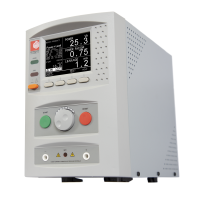Hipot testing, in conjunction with earth bond testing (where applicable) form the core tests for electrical safety testing on a production line.
The hipot test, derived from the term High Potential Test, is a direct application of a high voltage to a unit under test. The test voltage is usually much higher than the usual operating voltage in order to stress the dielectric properties of the device under test.
The test is designed to detect that gaps or clearances between conductive parts and earth (or the product chassis) are sufficient and that degradation, such as pin holes, cracks in insulation and other protection devices have not resulted through production processes and or wear and tear, for example, a live conductor has not accidentally been crushed between the mating parts of the chassis, causing it to become live when switched on.
Breakdown in the insulation will result in current flowing across the test points of the Hipot tester, this current flow is commonly known as leakage. If this leakage current is too high the item under test is deemed to be unsafe and the test will fail.
To find out more about electrical safety in manufacturing, please click on the banner below to download our free guide. Please get in touch with our specialist team if you have any questions about testing your products or our hipot testing solutions. We are always here to help.


















Sign up to our Newsletter.
Stay up to date with the latest industry and product news, as well as our free educational content such as webinars and our expert guides.
Close